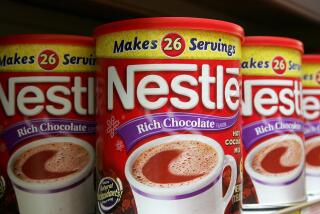Nickel in India Chocolate Triggers Scare
- Share via
NEW DELHI — When Ashok Aggarwal balked at buying his 5-year-old a candy bar and the boy threw a tantrum, they joined a great national debate about whether chocolate made in India is dangerous, even deadly.
Aggarwal tried to substitute cookies, but had no luck. Finally, embarrassed by his son’s howling in a crowded store, he bought an expensive bar of imported chocolate.
His fears were inspired by a report more than a year ago by Dr. M. C. Saxena, director of the private Environmental Research Laboratory in New Delhi, that Indian chocolate contained four to five times more nickel than popular brands made abroad. Chocolate manufacturers disputed the findings.
Saxena said nickel can cause cancer, inhibit children’s growth and impair their ability to form disease-fighting antibodies. People with prematurely gray hair also have high amounts of nickel in their bodies, he said.
By October of this year, traditionally the peak candy season because of a major Hindu festival, many stores were reporting a decline in chocolate sales of 20% to 30%.
“There seems to be a scare among the public,” said Ram Lal Bhatia, owner of a large sweet shop. “My customers are now buying boxes of assorted cookies.”
Normally, about 12,000 tons of domestic chocolate is consumed annually in India, most of it by the growing middle class.
Questions about nutrition and the safety of various foods are new to India, where consumerism is in its infancy. Hundreds of millions of poor Indians, who subsist on simple foods like rice and lentils, never even see chocolate.
This is the first time a warning about food has had a major effect on shopping habits, said H. D. Shourie, a former High Court judge who helped found a consumer-rights organization.
Saxena said his analysis of 11 brands of Indian chocolate showed that all used hydrogenated vegetable oil instead of more expensive cocoa butter to harden the chocolate.
Hydrogenated oil produced in India has a high nickel content, which Saxena said could be reduced to acceptable levels by better filtration.
The solidified vegetable oil also is commonly used for frying foods even in the poorest of homes, which would greatly broaden the scope of any health problem it causes.
Chocolate makers insist their products pose no health risks. They say there is not as much nickel as Saxena claims; that it enters the chocolate in milk, not the vegetable oil, and that scientists are divided about whether it can cause cancer or hinder growth.
One result of Saxena’s work has been a government decision to set standards for the nickel content of hydrogenated vegetable oil.
His initial findings won wider attention when the U.S. Embassy asked the Food and Drug Administration to check into the problem. The FDA replied that hypersensitive people might get a rash from the high level of nickel.
The Indian government appointed a board of experts to determine whether nickel is toxic and to set acceptable limits in food if necessary, with a report due in the spring. All domestic brands of chocolate are to be tested again in government labs.
Rajiv Lochan Mishra, the top bureaucrat in the Health Ministry, said after earlier government tests that Indian chocolate compared favorably with Western brands. Critics claimed the results were rigged.
Some parents seem to be taking it all calmly.
“Who knows, some scientist may say tomorrow that it’s not nickel that causes cancer, but something else,” said Vasanta Ramakrishnan, who still buys her children an occasional bar of Indian chocolate.
More to Read
Sign up for Essential California
The most important California stories and recommendations in your inbox every morning.
You may occasionally receive promotional content from the Los Angeles Times.











